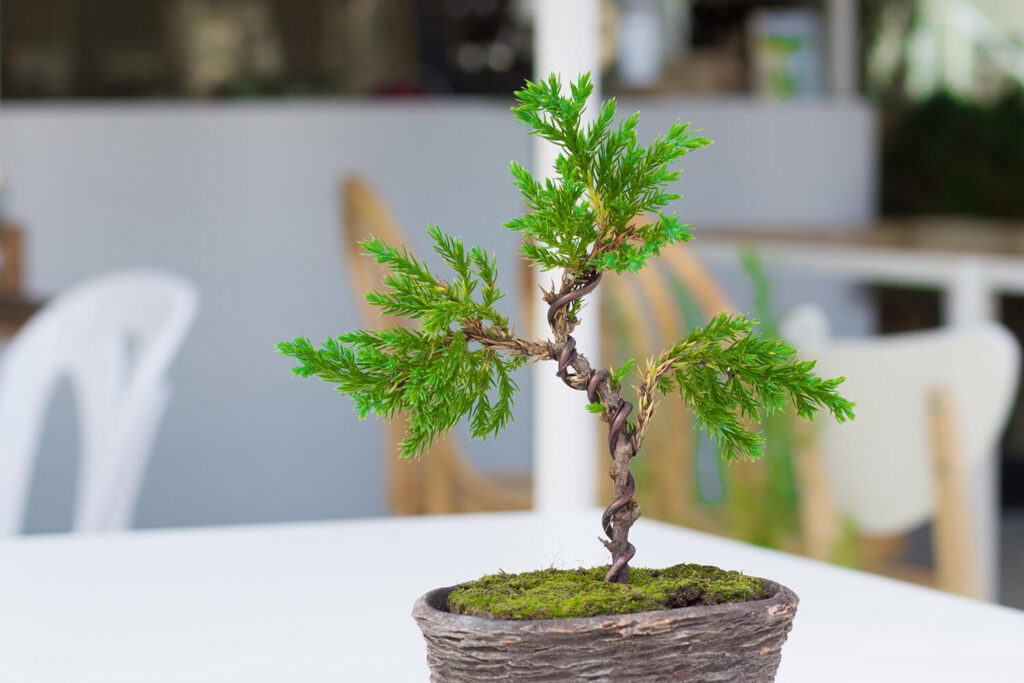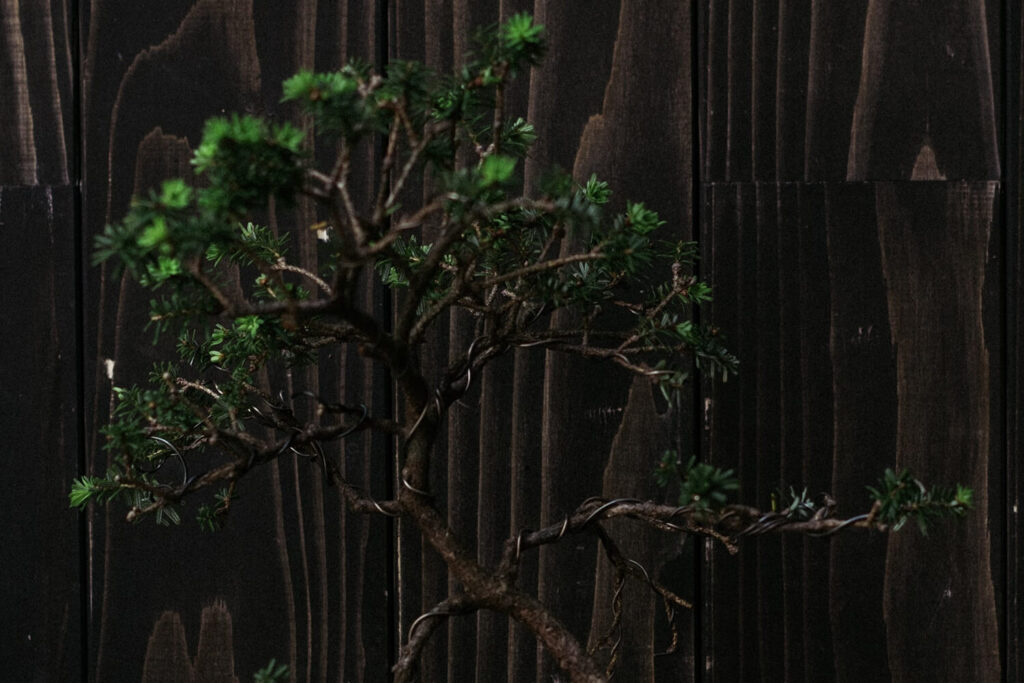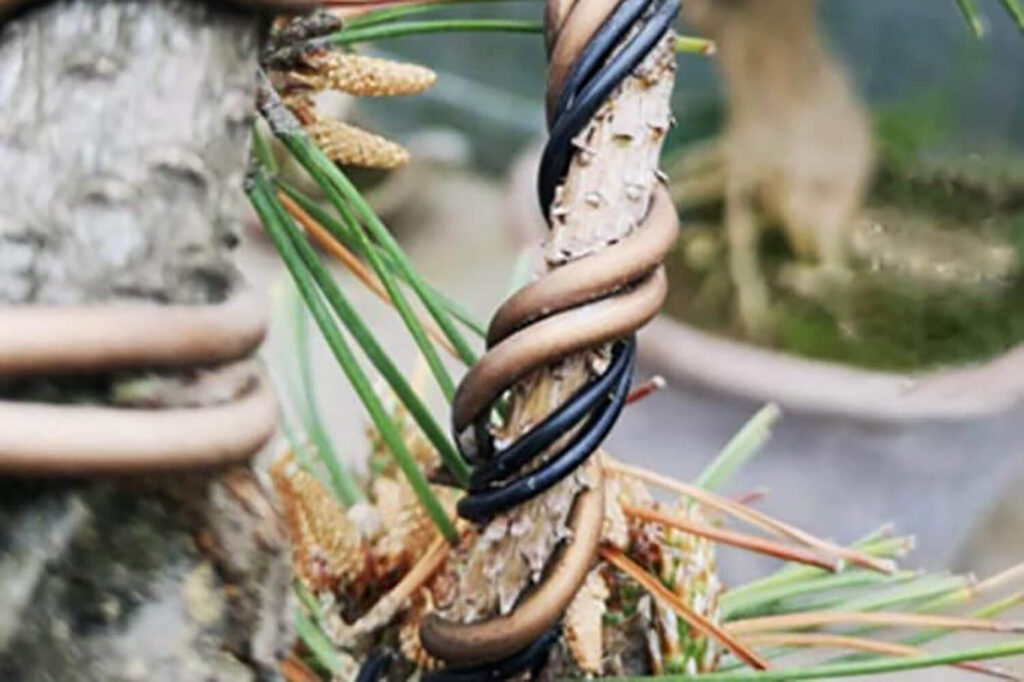DISCLAIMER: Hooked on Bonsai is a participant in the Amazon Services LLC Associates Program, an affiliate advertising program designed to provide a means for sites to earn advertising fees by advertising and linking to Amazon.com. Amazon and the Amazon logo or trademarks of Amazon.com, Inc. or its affiliates.
Shaping & wiring using bonsai wire is one of the core techniques of cultivating bonsai trees. It helps the tree look more aged and put together.
Although most bonsai artists get better at it through practice, wiring a bonsai tree for the first time can be nerve-wracking and difficult.
To help every beginner enthusiast, we’ve made a comprehensive guide on how to shape bonsai plants using bonsai tree wire.
Read on to know:
- When to apply and remove the wire from the tree.
- Several do’s and don’ts when applying wire to a bonsai.
- The benefit of wrapping raffia when bending a tree branch.
- What are copper and aluminum bonsai tree wire & when to use them.
- How to do the single-wiring, double-wiring, and anchor-wiring techniques.
- And much, much more…
Main Importance of Wiring Bonsai Trees
Wiring is done on bonsai trees for two main reasons: aesthetics and stability.
The goal of cultivating bonsai trees is to grow and train a mature miniature tree in a small, shallow pot. Although you can achieve that by potting a mature cutting in a bonsai pot, you can also accomplish that by wiring a young specimen to make it appear aged.
Applying wire, especially to the trunk and lower branches, can add a sense of age to the tree—making it look like it survived many years in extreme climates while still looking neat and clean.
Likewise, it helps create stability and refine the branch structure, helping bonsai growers achieve the growth and shape they want on their trees.
Things to Know When Wiring Bonsai Trees

Like any bonsai cultivation technique, wiring a tree should be performed at a proper time. Doing this not only helps bring great results but also helps prevent avoidable damage, particularly to the tree’s bark.
That said, here’s a guide on when and apply and remove the wire on bonsai trees:
When to Wire Bonsai Trees?
Most tree species can be wired any time of the year.
However, you must be extra careful during the growing season as branches tend to grow quickly, increasing the risk of wire cutting, which leaves ugly marks or scars on the bark.
Here’s when to best wire your bonsai depending on its tree classification:
- Conifer trees: any time of the year
- Deciduous trees: winter (once it’s semi-dormant/dormant and has no leaves)
When to Remove the Bonsai tree Wire?
Depending on the tree species, its branches may grow in around 1 to 4 months. Generally, you’d need to remove the wire within two months to avoid wire cutting.
As there are no set rules on when to remove the wire from the tree, many beginner bonsai growers tend to make mistakes often.
But here’s the trick…
Once you’ve wired your bonsai tree, check on it regularly—about once a week. Then, see if the wires are starting to bite into the bark. If so, gently remove the wire and reapply using a new set as needed.
Note: You’d need to check on your tree more often during the growing season as the branches grow faster.
2 Types of Bonsai Wires Used for Shaping Bonsai Trees
Before we dive into how to wire bonsai trees, let’s talk about the types of wires used in shaping bonsai trees.
There are two types of wires used by bonsai artists: aluminum and copper.
To know which one to use on your bonsai, read their uses and differences below:
Aluminum Wire
Best for: Broadleaf evergreen and deciduous trees
Aluminum wire has half the strength of copper, which makes it softer and easier to work with. Due to that, it’s less likely to damage the tree once the bark starts to bite in.
The aluminum wire should be applied tightly at a 45 to 50 degrees angle to position and bend branches safely.
Annealed Copper Wire
Best for: Conifers and pines
Annealed copper is a harder material, so it’s often used to hold stronger branches firmly in place. It’s also used as guy wire, interchangeably with steel wire, to bend branches or trunks drastically.
You should apply it firmly at a 60 to 65 degrees angle for proper support.
How to Choose the Right Size of Bonsai Wire?
Aside from deciding which type of wire to use, you should also consider the thickness or gauge of the wire.
There are various sizes of bonsai tree wires, from 1 mm to 8 mm (roughly gauges 20 to 2), and you should choose one that’s ⅓ the thickness of the branch you want to bend.
Generally, here’s what you should choose:
- Thin wire (1 mm to 2.5 mm): for thinner or younger branches
- Thick wire (3 mm to 8 mm) for thicker or old, mature branches
You don’t need to purchase every gauge of wire. If you’re a beginner, you may use aluminum or copper bonsai tree wires that are 1 mm to 4 mm thick.
Simple Step-By-Step Guides on Wiring Bonsai Trees
Wiring a bonsai tree can be tricky to master, especially as a beginner. To ensure proper support and neatness, you must apply the wire a certain way.
There are three basic ways you wrap wires on your bonsai:
Single-Wiring
When to do it: When wiring trunk and single branches

Step-by-step guide on single-wiring:
- Choose a copper or aluminum bonsai tree wire that’s ⅓ thick of the trunk or branch you want to shape.
- Cut the right length of wire—about twice the length of the trunk or branch you want to shape.
- Anchor one end of the wire to the closest strong trunk, branch, or bifurcation.
- Wrap the wire at a 45-degree angle from the lowest part of the trunk or branch to its tip.
- Safely bend or shape the trunk or branch you wired into its new position.
Note: If you need to wrap multiple wires to the same part of the tree, apply them neatly without crossing.
Double-Wiring
When to do it: When wiring two branches with the same thickness
Step-by-step guide on double-wiring:
- Select a pair of nearby branches with the same thickness.
- Get a bonsai tree wire that’s ⅓ thick of the branches.
- Cut the wire about twice the length of the two branches.
- Wrap the center of the wire, preferably twice, to the bifurcation for stronger support.
- Apply the first half of the attached wire to one of the branches at a 45-degree or 60-degree angle. Then, wrap the second half to the other branch.
Note: If you want to bend a branch downward, apply the bonsai tree wire from below. If upwards, wrap the wire from above.
Anchor Wiring
When to do it: When bending a trunk or branch dramatically & bending too thick or brittle branches
Step-by-step guide on anchor-wiring:
- Find an anchor point located along the part you want to bend. It can be a lower branch, jin, surface root, or a part of a bonsai pot. You can also drill screws on the trunk or pot to create an anchor point.
- Make a guy wire using a 1 mm steel or copper wire. Then, cut it long enough that you can loop it once from the part you want to bend to the anchor point.
- Loop the center of the guy wire to the anchor point. Then, twist the two ends together on top of the part you want to bend.
- Twist it a few more times until you achieve your desired goal.
Tip: Wrap a small piece of rubber or plastic around the part where you want to place the guy wire to protect the bark from wire bit caused by too much force.
You can also watch this video to learn how to apply wire on bonsai trees:
Bending the Wired Branches
Once you’ve wired your bonsai, you may bend it to your desired shape. Although it may look easy, bending a bonsai tree requires caution.
To help you out, here’s a step-by-step guide on bending bonsai trees:
- Gently hold the part of the branch you want to bend with your fingers.
- Slowly bend it to the direction or shape you want using your thumb.
- Once positioned, avoid moving or reshaping it to avoid breakage.
Note: Aside from wiring the tree following the three techniques above, you may also put a straight backbone wire along the trunk line for extra support.
Do’s and Don’ts When Wiring Bonsai Trees

Now that you know the basics of choosing a wire type & size, applying the wire, and bending a wired part, let’s discuss some of the important do’s and don’t when performing bonsai wiring:
DO’s
- Apply wire only to healthy and strong bonsai trees.
- Wire a bonsai tree from bottom to top and inside to outside.
- Choose the right bonsai tree wire for conifer and deciduous trees.
- Always wire foliage in a fan-shaped form to allow sunlight to enter.
- Only make vigorous bends on healthy, vigorous bonsai specimens.
- Remove the wire from the tree by cutting it at every turn using a bonsai wire cutter.
- Cut and loop the end of the wire underneath the branch, and lift the foliar tips slightly upwards.
DON’Ts
- Avoid unnecessary foliar layering when wiring conifers and pines.
- Avoid bending and damaging the needles, as they can cause the yellowing of leaves.
- Don’t reuse any aluminum wire or annealed copper wire, as they have most likely lost their strength already.
Other Wiring Materials You Should Use
Aside from the bonsai tree wires, there are a few more things you would need to perform bonsai wiring conveniently.
Note: While having these tools can make your work more convenient, you should only purchase them if necessary.
1. Raffia strips
Raffia is a palm fiber strip used in bonsai art to help avoid old and brittle branches from breakage when heavy-bending. It can also be applied on any part of the tree to protect the bark from wire bits.
Here’s a step-by-step guide on how to apply raffia on bonsai:
- Get a suitable amount of raffia—more or less 10 strips—then knot it on one end.
- Soaked the raffia strips in water.
- Position the knotted end to the lower or inner part of the branch you want to wire and bend.
- Wrap the raffia strips tightly and without spaces from inside to outside.*
- Know the remaining end of the raffia strips to secure them in place. Then, add a second round of raffia if necessary.
- Cut off loose threads
*Note: Wrap the raffia in the same direction you want to bend the branch.
2. Branch bender
If you want to make heavy bending, you should use a branch bender. It’s a bonsai tool used for bending thicker branches more securely.
Here’s a step-by-step guide on using a branch bender:
- Position the center of the tool to the part you want to bend.
- Insert the branch into the clamps.
- Then, gently tighten the screw to secure the tool in place.
3. Bonsai tree wire cutter
Although you can use a regular wire cutter to cut wires, using a bonsai tree wire cutter is preferred, especially when removing attached wires to the tree. Its slim blade design allows bonsai growers to snip wires on tighter areas without damaging the tree’s bark.
Conclusion
As you can see, bonsai wiring can be a challenging task if you’re a beginner. Nonetheless, anyone can master it through a series of continuous practices.
When wiring a bonsai tree, remember to choose the right wire type and size, as these things can directly affect the result of your work. Also, always follow the right techniques and use appropriate bonsai tools.
Visit www.hookedonbonsai.com to learn other important bonsai cultivation techniques.





0 Comments